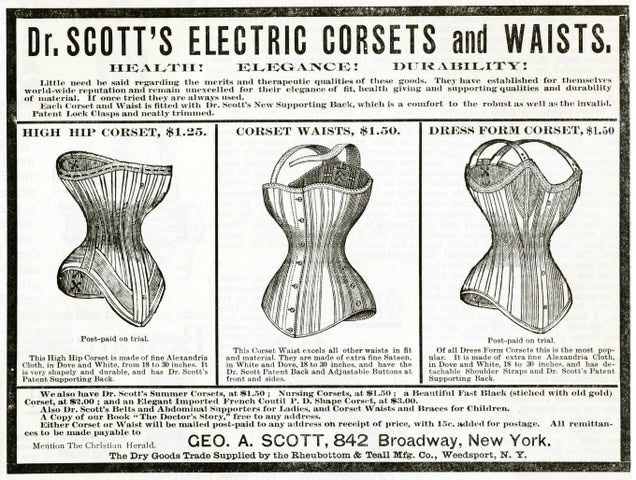TOXIC FASHION TRENDS OVER THE YEARS
We’ve heard, much less lived, the phrase “pains for beauty”. It may rear its ugly head while struggling into our spanx, attaching fake lashes or teetering around in those six-inch Jimmy Choo stilettos that were really the ONLY thing to go with your True Fashionista outfit. Perhaps there’s a flashback to laying down flat on your bed in order to zip up those Calvin Klein jeans. Breathing? NOT important! As it goes, the oft-questionable things we do nowadays to attain just the True Fashionista look we crave actually pale in comparison to some of the accepted beauty practices of days (thankfully!) gone by.
FOOT BINDING
Foot binding was a sign of wealth and marriage eligibility practiced in China, dating back to the Song dynasty, beginning 961 AD right up until the early 20thcentury, when anti-foot binding campaigns were successful in ending the procedure. This exercise of wrapping the feet in tight binding in order to “mold” them into the desired triangular, pointed shape most often resulted in severe disabilities. Feet altered by binding were known as “lotus feet”.
CORSETS
In Europe and here in the U.S., the more widely known rather uncomfortable beauty practice of wearing a corset was introduced in the middle ages and refined over the years. In the 16thcentury, Corsets were worn to achieve the desired “hourglass” look, drawing in the waist and lifting the bustline. In their construction at this time, corsets featured whalebone sewn in for stiffness, restricting women’s breathing and sometimes breaking a rib here and there. The resulting discomfort also served as an effective appetite suppressant, which in turn caused frequent fainting. Corsets in a less restricting form remain in existence up to today, more as a True Fashionista fashion and sometimes, fetish statement. But we digress…
BELLADONNA
Belladonna, also known as deadly nightshade, is one of the most toxic plants in the eastern hemisphere. It’s also Italian for beautiful lady, so go figure. Women in Renaissance-era Italy would extract the juice from the plant’s berries and drop it into their eyes, widening their pupils in an attempt to simulate arousal and subsequently, desirability. Unfortunately, too much use could also result in permanent blindness. These days, belladonna extract is still widely used therapeutically, and can be found in asthma and whooping cough medicines, as well as those for hemorrhoid relief and psychiatric treatments. Just please, keep it out of your eyes, people! Unless you’re at the eye doctor because yes, a synthetic version thereof is what they use for pupil dilation.
ARSENIC
In Victorian-era Great Britain, arsenic was revered for its magnificent green hues and widely used in a variety of ways including women’s clothing, artificial flower arrangements, candles, wallpaper, even women’s shoeboxes. Over time, a connection was slowly made between its use and burgeoning reports of horrible sickness and death among workers in the factories as well as consumers. Once arsenic’s true toxicity came to light, the inevitable wave of arseno-phobia began, and with good reason, as documented in James Whorton’s book, The Arsenic Century: How Victorian Britain was Poisoned at Home, Work and Play (2010).
HOOP SKIRTS
Back to the 19thCentury Victorian era we go for the origin of another dangerful (is that a word?) fashion trend, the inimitable hoop skirt, also known as crinoline. Originally intended to enhance a women’s silhouette, these skirts had a metal cagelike underwire surrounding the wearer’s body, covered with material made of horsehair and cotton. As hoop skirts grew in popularity, so did their size. Unfortunately, accidents started to happen when wearers sashayed into the room, and candles would get knocked over, catching them on fire. Thevintagenews.com also reports how the hoops would get caught in machinery or be run over by carriage wheels, also typically resulting in serious injury to the wearer.
 TEETH BLACKENING
TEETH BLACKENING
Tooth blackening, or Ohaguro, was popular through history in Vietnam and Japan up until the late 19thcentury. Having black teeth was a sign of marriage eligibility, sexual maturity and beauty. (Yes really!) The look was achieved by drinking an iron-based dye on a regular basis. This dye was so harsh-tasting that a variety of spices like cinnamon, cloves and anise would be added. Ingesting the dye often caused severe reactions to the chemicals, and this ritual was finally banned by the Japanese government in 1870.
Whether you’re donning something ill-fitting or having an extended, involved skin treatment, chances are you’re still doing less to your poor body than any of these trends from our not-so True Fashionista past. Carry on!
The post TOXIC FASHION TRENDS OVER THE YEARS appeared first on True Fashionistas.





























